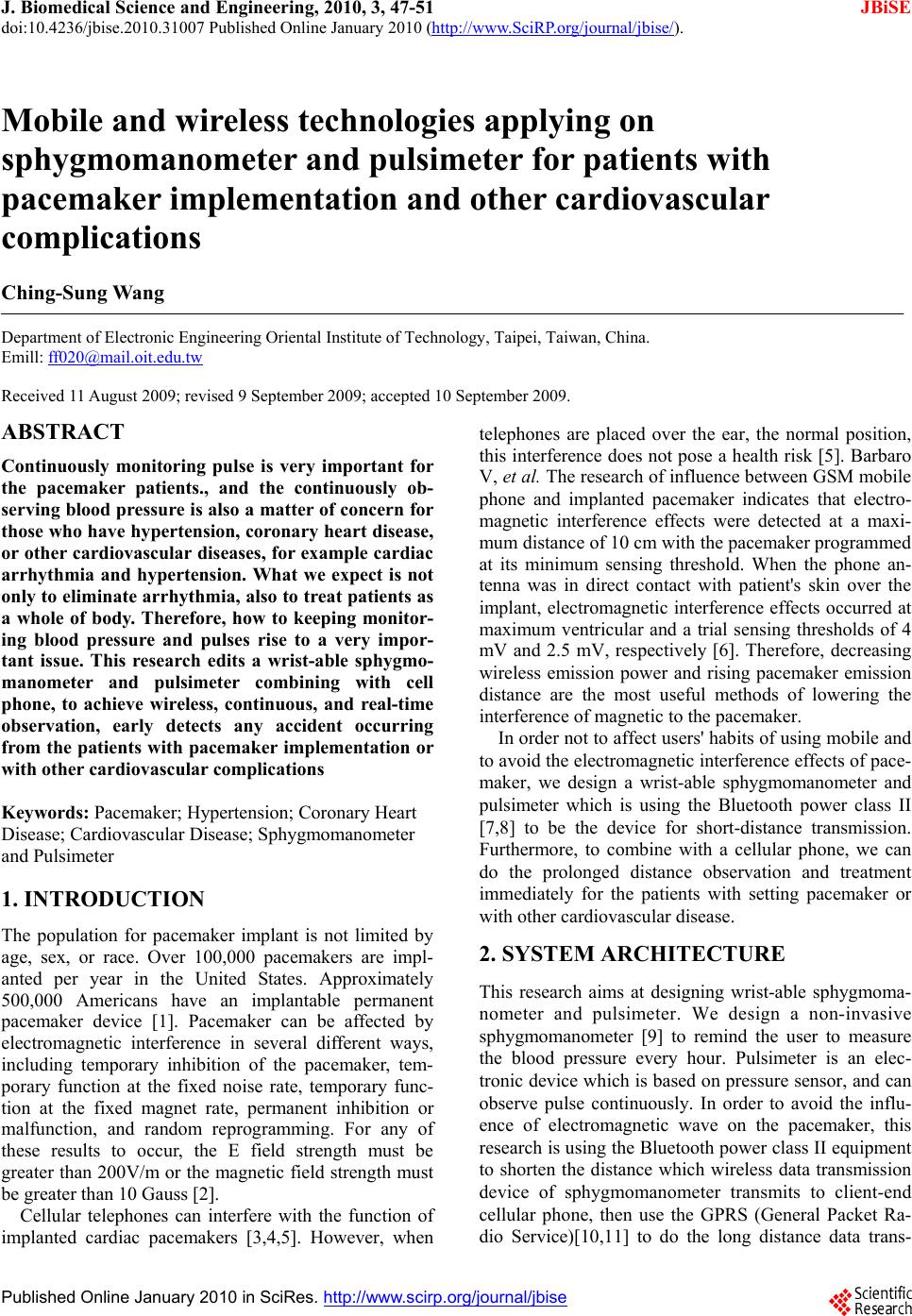
J. Biomedical Science and Engineering, 2010, 3, 47-51
doi:10.4236/jbise.2010.31007 Published Online January 2010 (http://www.SciRP.org/journal/jbise/
JBiSE
).
Published Online January 2010 in SciRes. http://www.scirp.org/journal/jbise
Mobile and wireless technologies applying on
sphygmomanometer and pulsimeter for patients with
pacemaker implementation and other cardiovascular
complications
Ching-Sung Wang
Department of Electronic Engineering Oriental Institute of Technology, Taipei, Taiwan, China.
Emill: ff020@mail.oit.edu.tw
Received 11 August 2009; revised 9 September 2009; accepted 10 September 2009.
ABSTRACT
Continuously monitoring pulse is very important for
the pacemaker patients., and the continuously ob-
serving blood pressure is also a matter of concern for
those who have hypertension, coronary heart disease,
or other cardiovascular diseases, for example cardiac
arrhythmia and hypertension. What we expect is not
only to eliminate arrhythmia, also to treat patients as
a whole of body. Therefore, how to keeping monitor-
ing blood pressure and pulses rise to a very impor-
tant issue. This research edits a wrist-able sphygmo-
manometer and pulsimeter combining with cell
phone, to achieve wireless, continuous, and real-time
observation, early detects any accident occurring
from the patients with pacemaker implementation or
with other cardiovascular complications
Keywords: Pacemaker; Hypertension; Coronary Heart
Disease; Cardiovascular Disease; Sphygmomanometer
and Pulsimeter
1. INTRODUCTION
The population for pacemaker implant is not limited by
age, sex, or race. Over 100,000 pacemakers are impl-
anted per year in the United States. Approximately
500,000 Americans have an implantable permanent
pacemaker device [1]. Pacemaker can be affected by
electromagnetic interference in several different ways,
including temporary inhibition of the pacemaker, tem-
porary function at the fixed noise rate, temporary func-
tion at the fixed magnet rate, permanent inhibition or
malfunction, and random reprogramming. For any of
these results to occur, the E field strength must be
greater than 200V/m or the magnetic field strength must
be greater than 10 Gauss [2].
Cellular telephones can interfere with the function of
implanted cardiac pacemakers [3,4,5]. However, when
telephones are placed over the ear, the normal position,
this interference does not pose a health risk [5]. Barbaro
V, et al. The research of influence between GSM mobile
phone and implanted pacemaker indicates that electro-
magnetic interference effects were detected at a maxi-
mum distance of 10 cm with the pacemaker programmed
at its minimum sensing threshold. When the phone an-
tenna was in direct contact with patient's skin over the
implant, electromagnetic interference effects occurred at
maximum ventricular and a trial sensing thresholds of 4
mV and 2.5 mV, respectively [6]. Therefore, decreasing
wireless emission power and rising pacemaker emission
distance are the most useful methods of lowering the
interference of magnetic to the pacemaker.
In order not to affect users' habits of using mobile and
to avoid the electromagnetic interference effects of pace-
maker, we design a wrist-able sphygmomanometer and
pulsimeter which is using the Bluetooth power class II
[7,8] to be the device for short-distance transmission.
Furthermore, to combine with a cellular phone, we can
do the prolonged distance observation and treatment
immediately for the patients with setting pacemaker or
with other cardiovascular disease.
2. SYSTEM ARCHITECTURE
This research aims at designing wrist-able sphygmoma-
nometer and pulsimeter. We design a non-invasive
sphygmomanometer [9] to remind the user to measure
the blood pressure every hour. Pulsimeter is an elec-
tronic device which is based on pressure sensor, and can
observe pulse continuously. In order to avoid the influ-
ence of electromagnetic wave on the pacemaker, this
research is using the Bluetooth power class II equipment
to shorten the distance which wireless data transmission
device of sphygmomanometer transmits to client-end
cellular phone, then use the GPRS (General Packet Ra-
dio Service)[10,11] to do the long distance data trans-